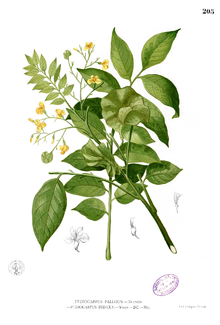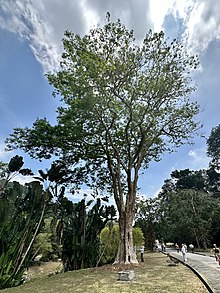Pterocarpus indicus
| Pterocarpus indicus | |
|---|---|

| |
| Scientific classification | |
| Kingdom: | Plantae |
| Clade: | Tracheophytes |
| Clade: | Angiosperms |
| Clade: | Eudicots |
| Clade: | Rosids |
| Order: | Fabales |
| Family: | Fabaceae |
| Subfamily: | Faboideae |
| Genus: | Pterocarpus |
| Species: | P. indicus
|
| Binomial name | |
| Pterocarpus indicus | |
| Synonyms[2] | |
|
List
| |
Pterocarpus indicus(commonly known asAmboyna wood,Malay padauk,Papua New Guinea rosewood,Philippine mahogany,Andaman redwood,Burmese rosewood,narra[3](fromTagalog[4]) andasanain the Philippines,angsana,orPashu padauk) is a species ofPterocarpusnative to southeastern Asia, northernAustralasia,and the western Pacific Ocean islands, in Cambodia, southernmost China,East Timor,Indonesia, Malaysia,[5]Papua New Guinea, the Philippines, theRyukyu Islands,theSolomon Islands,Thailand, and Vietnam.[6]
Pterocarpus indicuswas one of two species (the other beingEysenhardtia polystachya) used as a source for the 16th- to 18th-century traditionaldiureticknown aslignum nephriticum.[7]
Many populations ofPterocarpus indicusare seriously threatened. It is extinct in Vietnam and possibly in Sri Lanka and Peninsular Malaysia.[1]It was declared the national tree of the Philippines in 1934 byGovernor-GeneralFrank Murphyof theInsular Government of the Philippine Islandsthrough Proclamation No. 652.[8]
Description
[edit]


It is a largedeciduoustree growing to 30–40 m tall, with a trunk up to 2 m diameter. Theleavesare 12–22 cm long, pinnate, with 5–11 leaflets, the girth is 12–34 m wide. MostPterocarpusspecies prefer seasonal weather butP. indicuspreferrainforests.
Theflowersare produced inpanicles6–13 cm long containing a few to numerous flowers; flowering is from February to May in the Philippines, Borneo and the Malay peninsula. They are slightly fragrant and have yellow or orange-yellow petals. Thefruitis a semiorbicularpod2–3 cm diameter, surrounded by a flat 4–6 cm diameter membranaceous wing (wing-like structure) which aids dispersal by the wind. It contains one or twoseeds,and does not split open at maturity; it ripens within 4–6 years, and becomes purple when dry. The central part of the pod can be smooth (f.indica), bristly (f.echinatus(Pers.) Rojo) or intermediate.[9][10]
Note:Pterocarpus macrocarpus,a similar species native toBurma,is referred to as "Rosewood" throughout South East Asia.P. macrocarpusis usually harder thanP. indicus.When in burl form both are referred to as Amboyna Burl.
Uses
[edit]The hardwood, which is purplish, istermite-resistant and rose-scented. The wood known in Indonesia asamboynais theburlof the tree, named afterAmbon,where much of this material was originally found. Often amboyna is finely sliced to produce an extremely decorative veneer, used for decoration and in making of furniture and keys on amarimba.
It is a premium timber species suitable for high grade furniture, lumber and plywood for light construction purposes. It is also used for cartwheels, wood carving and musical instruments.[11]
The flower is used as a honey source while leaf infusions are used as shampoos. Both flowers and leaves were said to be eaten. The leaves are supposedly good for wa xing and polishing brass and copper. It is also a source of kino orresin.[10]
The leaves of narra are also used in traditional medicine to treat a variety of health problems. Narra leaves contain flavonoids. Flavonoids are antioxidants that provide health benefits to humans, such as anti-inflammatory and anti-allergic benefits. Flavonoids in narra leaves may be capable of preventing damage to your kidneys.[12]
In folk medicine, it is used to combat tumors.[10]This property might be due to an acidicpolypeptidefound in its leaves that inhibited growth ofEhrlich ascites carcinomacells by disruption of cell and nuclear membranes.[citation needed]It was also one of the sources oflignum nephriticum,adiureticinEuropeduring the 16th to 18th centuries. Its reputation is due to its wood infusions, which arefluorescent.[7]
The tree is recommended as anornamental treeforavenuesand is sometimes planted inPuerto Ricoas a shade and ornament. The tall, dome-shaped crown, with long, drooping branches is very attractive and the flowers are spectacular in areas with a dry season. It is very easily propagated from seed or large stem cuttings, but suffers from disease problems. It is widely planted as a roadside, park, andparking lottree.
In agroforestry, it maintains ecosystem fertility and soil stability. Narra is a leguminous plant that is capable of fi xing nitrogen by forming endosymbiotic relationships with nitrogen-fi xing bacteria that lives in its root nodules. Nodulating leguminous plants, such as narra, are responsible for transforming atmospheric nitrogen into a plant-usable form.
In the Philippines, a permit is required to cut the narra (cf.TagalogandCebuanonára,Maranaonara),[13]but nevertheless the popular sturdy wood is widely used for construction and furniture projects.[14]
In Singapore, the ease to propagate the tree made it a favourite for the urban planners in Singapore to plant new trees via monoculture in a campaign to transform the rapidly urbaning city into a green city in between 1969 and 1982.[15][16]In 1985, 1,400 trees died due to "Angsana Wilt Disease," and were cut down.[16]It was found that thefusarium oxysporumfungi species was the cause of the disease.[16]The fungus was carried byambrosia beetlesboring into the trees.[17]The infection was eventually controlled by a combination of monitoring, removal of lightning-damaged trees, and replanting with identified disease-resistant varieties.[18]
Symbolism
[edit]It is thenational treeof the Philippines,[8]as well as the provincial tree ofChonburiandPhuketin Thailand.

References
[edit]- ^abBarstow, M. (2018)."Pterocarpus indicus".IUCN Red List of Threatened Species.2018:e.T33241A2835450.doi:10.2305/IUCN.UK.2018-2.RLTS.T33241A2835450.en.Retrieved19 November2021.
- ^"Pterocarpus indicusWilld ".The World Flora Online.World Flora Consortium. 2023.Retrieved18 October2023.
- ^"Pterocarpus indicus".Germplasm Resources Information Network.Agricultural Research Service,United States Department of Agriculture.Retrieved6 July2017.
- ^Merrill, Elmer Drew(1903).A dictionary of the plant names of the Philippine Islands.Manila: Bureau of Public Printing,Department of The Interior.p. 179 – via University of Michigan Digital Collections.
- ^Gardner, Simon; Sidisunthorn, Pindar; Ee, Lai (2011).Heritage Trees of Penang.George Town, Penang, Malaysia: Areca Books.ISBN978-967-57190-6-6.[page needed]
- ^"Pterocarpus indicus".International Legume Database & Information Service.Archived fromthe originalon 8 June 2011.
- ^abMuyskens, M.; Ed Vitz (2006). "The Fluorescence ofLignum nephriticum:A Flash Back to the Past and a Simple Demonstration of Natural Substance Fluorescence ".Journal of Chemical Education.83(5): 765.Bibcode:2006JChEd..83..765M.doi:10.1021/ed083p765.
- ^abPangilinan, Leon Jr. (3 October 2014)."In Focus: 9 Facts You May Not Know About Philippine National Symbols".National Commission for Culture and the Arts.Archivedfrom the original on 26 November 2016.Retrieved8 January2019.
- ^Danida Seed Leaflet:Pterocarpus indicus(pdf file)Archived9 April 2008 at theWayback Machine
- ^abcPurdue UniversityNew Crops:Pterocarpus indicusArchived5 February 2007 at theWayback Machine
- ^Carandang, 2004[incomplete short citation]
- ^Saputri et.al., 2007[incomplete short citation]
- ^Blust, Robert; Trussel, Stephen (2010)."*nara a tree: Pterocarpus indica".Austronesian Comparative Dictionary.Max Planck Institute for Evolutionary Anthropology.Retrieved8 November2022.
- ^Pangilinan, Leon, Jr. (3 October 2014)."9 Facts You May Not Know About Philippine National Symbols".In Focus.National Commission for Culture and the Arts.Archivedfrom the original on 26 November 2016.Retrieved20 January2016.
{{cite web}}:CS1 maint: multiple names: authors list (link) - ^"SOTA's Angsana tree to be removed due to decay".TODAY.Retrieved1 February2023.
- ^abcYeo, Hwee Yng (22 December 1992)."New treatment found for diseased Angsana trees".The Straits Times.p. 25.Retrieved1 February2023.
- ^Sanderson, F. R.; Fong, Yok King; Saiful Anuar; Yik, Choi Pheng; Ong, Keng Ho (1996).A Fusarium Wilt (Fusariurn oxysporum) of Angsana (Pterocarpus indicus) in Singapore(PDF)(Report).
- ^Mystery Plague That Killed Singapore's Angsanas | Secret Lives Of Trees (Part 1/2) | Full Episode(documentary),CNA,12 January 2023,retrieved1 February2023
External links
[edit]- Pterocarpus indicus(narra).Images and references – (2006) 17p
- PIER species info:Pterocarpus indicus
![]() Media related toPterocarpus indicusat Wikimedia Commons
Media related toPterocarpus indicusat Wikimedia Commons


